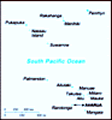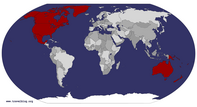Advertisement
Published: September 17th 2008

 The Set Up
The Set Up
So here's the set up. A level string goes down the center of the boat providing one reference axis. Then a level beam goes across providing another. I measure the distance away from the end, how far I am off center, and how far down to the hull to get the 3D coordinates of the hull. The level you see in the foreground is just sitting there. You can also see the laser rangefinder with jig sitting on the beam. Ben's carving away in the background. Taking Offsets
One of the things I’m really interested in doing is taking the offsets from as many boats as I can. The offsets let me have a way of comparing different boats without having the boats next to each other. In effect it lets me turn the hull into a bunch of numbers. With these numbers I hope to create digital models of the canoes (working on an ama right now), allowing me to put two canoes from different parts of the world next to each other. I also hope that in the future I may be able to do some hydrodynamic analysis of the models to see which are more efficient.
The biggest problem is convincing people to allow me to take offsets. With them I could potentially make a new mold and copy their boats. This, of course, is not my intention at all. But the other aspect of this problem is that I would like to publicize some of my findings, if I get any. If I do that, how can I guarantee that no one else copies them? I don’t have the answer to this yet. I’m thinking that may

 Measuring
Measuring
Another brilliant self portrait. You can see how I get tired of measuring after a bit. Beard's back too. I'll also comment that there is so much stuff in my pockets when I'm doing this. Camera (not at this moment obviously), pens, pencils, rules, wallet, just about everything you can imagine.be I only put up pictures of the models and any analysis results - not the actual file that they could go into and take the offsets from - but this is something I’ll figure out when I get a bit more along in the project.
What I can say now is how I do it. Just a warning here: the following is pretty long and detailed. If you aren’t too worried about the details it’s pretty much summed up in the picture descriptions and I’d suggest reading those.
The first step is to set up what I’m taking offsets from. Since these boats are relatively small I flip them upside down so I’m measuring down or horizontally to the hull instead of up. Next I make sure that the boat or ama is as level as I can make it. For the canoes I use the gunnels, for the ama this is a bit trickier and I pretty much guess because they don’t have much for flat surface.
Next step is to set up a reference plane. To do this I place two stands at either end of the canoe and tie a

 The Ama
The Ama
Here's what the ama looks like when I'm done. You can see the stripes I put on locating each station. The whole set up is at the right hand side of the shot. The whole thing is 4.4m long.string taut between them. I put this right down the center of the canoe, a few inches above. If I wasn’t using a laser range finder - which I’ll explain later - I would leave the string so that it just touches the hull. This string is the first reference axis and it’s very important it doesn’t move or get shifted. I made sure to tell the guys in the shop it’s important they don’t disturb and if they did to let me know (I’d be very pissed if I got done and noticed the hull jumped someway half way through).
Two stands adjacent to the hull then hold a beam over the string so that the beam is perpendicular to the string, forming a sort of cross. I’m using wood for this although a level with length measurements would be ideal. The beam needs something to mark the center of it, so this point can be placed over the string, and then I taped a ruler to it so I could know how far away from the center of the hull I was. This beam is placed so that the base of it is just touching the string as so that it is level. This gives me a second reference axis, which combines with the first to give me a reference plane. In theory it should be parallel to the ground but I’m rarely working on a level floor. If I was I probably wouldn’t have to pay so much attention to the level and could just keep everything the same height off the ground, but I don’t have that benefit.
The final third axis is gravity. Since everything above is level I can measure straight down and have no problems.
This is, in theory, all I need. The problem is that, since I’m measuring down and taking steps sideways, I won’t get good measurements if the sides of the hull are very steep. To solve this I also take the offsets horizontally too. Since I wasn’t planning on doing this I had to innovate but what I decided to do was hang a measuring tape from the beam. Since I knew how far off the string the tape measure was (because of the ruler) and I could know how far down the tape measure I was because it was a tape measure I could get points that way too. I don’t know if this was the best solution because I know that the bulk of the tape measure made it so the tape didn’t hang perfectly perpendicular. I’m assuming that this was negligible.
So that’s the basic set up. I’ll point out that, as some of you probably noted, since I’m using the beam over the string, measuring from the top of the beam, and it’s the bottom of the beam that contacts the string, the string isn’t actually an axis or even on the reference plane. The ‘true’ reference plane is on top of the beam. The reference plane could be just about anywhere however, so this is an irrelevant concern. Just thought I’d mention it for all the engineers out there.
The next step is the fun one for about two stations and then gets boring and Krauss gets grumpy. The first step to measuring is more of a helpful than necessary one. What I do is fire a plane laser down onto the hull from the beam, giving a line of where I’m going to measure the offsets. I’m using a laser level for this (meant for hanging pictures) so it has a level built in, allowing me to make sure the laser fires straight down. Where the laser hits the hull I draw a line with something erasable. Later on is when I find out that erasable markers don’t erase on scratched up parts of the hull. Pencil is harder to see but comes off better.
The reason for this is so that I don’t have to attach a level onto the laser to make sure I’m firing straight down and pay attention to that every time. Instead I just point the laser to this line, knowing it is directly below where I am measuring from. I’ll point out here that I also set up a jig for the laser so I know it’s flush with the beam. This is because the front of the laser is rounded, if you were using a different measuring apparatus you may not need this. The laser rangefinder has a minimum distance of 2 inches or so, that’s why I said I need to keep the string a little above the highest point of the hull.
Next thing is to set up your stations. The stations are where I’m taking the offsets from and it’s where I set up the stands with the beam. For the purpose of the ama I put a station every 20 cm giving me 21 stations. How many stations you need is largely a judgment call. If the geometry is changing a lot, more stations may help you capture the geometry better. But if it isn’t changing that just means more time measuring. Either way, measure your stations from either the bow or the stern, doesn’t matter. I draw a mark on the string where I want the stations so that I don’t have to be measuring and setting up the stand at the same time.
Now I just measure. Because the ama is narrow I took measurements every centimeter. This was probably excessive, but I’m picky. For the horizontal offsets, based on the measuring tape, I went every inch because I only have an English measuring tape (was pretty disappointed to find that out, I think I lent out my metric one sometime at Union last year, probably to someone in College Park Hall if you want to confess). I know mixing units is bad and evil and all that but I didn’t have a choice.
The next step is to continue measuring. Then measure some more. Stretch out the back because I’m bending over all time. It becomes pretty routine after a while. I determined I took 16 minutes per station with surprising consistency considering sometimes I had to re-level the beam and sometimes I didn’t. That was 9 minutes taking measurements and 7 setting up the station.
So that’s the procedure. If you want to post and let me know what parts are unclear I’d appreciate it, tried to be as concise as possible. Hope the pictures help!
Advertisement
Tot: 0.142s; Tpl: 0.011s; cc: 5; qc: 44; dbt: 0.0422s; 1; m:domysql w:travelblog (10.17.0.13); sld: 1;
; mem: 1.1mb









